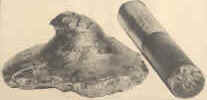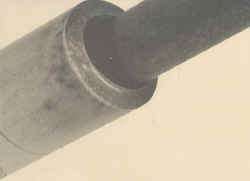
G&S Valves Ltd
Manufacturing Bespoke Engine Valves Since 1946
General Faults: Mechanical Faults
Examples of breakages:

Effect: Fatigue break.
Cause: This is fatigue type failure caused by a gradual breakdown of the material due to excessive cyclic stresses, high cylinder pressure and excessive valve temperature.
Example: A fatigue break normally shows lines of progression (see picture).

Effect: Impact break.
Cause: This is a impact type failure (mechanical breakage of the valve).
Example: A impact break normally shows radial lines (see picture).

Effect: Valve head to stem breakage in the region of the junction of the underhead radius with the stem.
Cause: Excessive cyclic stem stresses brought about by one or more of the following, valve bounce due to overspeed or weak valve springs, seating velocity too high due to excessive tappet clearance or loss of valve retainer. Piston to valve collision due to overspeed or incorrectly set valve timing or sticking.

Effect: Valve stem breakage through collet groove.
Cause: This type of valve is usually hardened through the cotter grooves and is susceptible to failure due to overspeeding or valve bounce.
Effect: Excessive valve stem and guide wear.
Cause: To much valve stem to guide clearance; poor stem lubrication; poor stem to guide alignment.

Effect: Valve stem sticking or seizing.
Cause: A lack of lubrication; not enough stem to guide clearance; bent valve stem; carbon build up at the bottom of the valve stem, incompatible valve to guide material.

Effect: Exhaust valve seat wear.
Cause: Incorrect fuel; valve seat misalignment; weak valve springs worn guides.

© Copyright G&S Valves 2014
Website Design by heatherdesign.co.uk